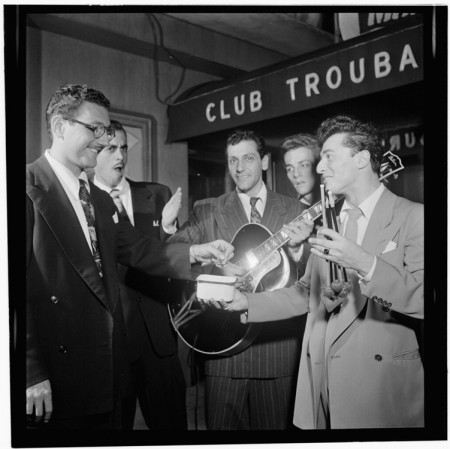6.10: Pop Culture and Subculture
- Page ID
- 60122
Learning Outcomes
- Discuss the roles of high culture, pop culture, subculture, and counterculture within society
High Culture and Popular Culture
Do you prefer listening to opera or hip hop music? Do you like watching horse racing or NASCAR? Do you read books of poetry or celebrity magazines? In each pair, one type of entertainment is considered high-brow and the other low-brow. Sociologists use the term high culture to describe the pattern of cultural experiences and attitudes that exist in the highest class segments of a society. People often associate high culture with intellectualism, political power, and prestige. In America, high culture also tends to be associated with wealth. Events considered high culture can be expensive and formal—attending a ballet, or listening to a live symphony performance, for example.
The term popular culture refers to the pattern of the more accessible cultural experiences and attitudes that exist in mainstream society. Popular culture events might include a parade, a baseball game, or the season finale of a television show. Rock and pop music—“pop” is short for “popular”—are part of popular culture. Popular culture is often expressed and spread via commercial media such as radio, television, movies, the music industry, publishers, and corporate-run websites. Unlike high culture, popular culture is known and accessible to most people. You can share a discussion of favorite football teams with a new coworker or comment on American Idol when making small talk in line at the grocery store. But if you tried to launch into a deep discussion on the classical Greek play Antigone, few members of U.S. society today would be readily familiar with it.
Although high culture may be viewed as superior to popular culture, the labels of high culture and popular culture vary over time and place. Shakespearean plays, considered pop culture when they were written, are now part of our society’s high culture. Five hundred years from now, will our descendants associate Breaking Bad with the cultural elite?
Subculture and Counterculture
A subculture is just what it sounds like—a smaller cultural group within a larger culture; people of a subculture are part of the larger culture but also share a specific identity within a smaller group.
Thousands of subcultures exist within the United States. Ethnic and racial groups share the language, food, and customs of their heritage. Other subcultures are united by shared experiences. Biker culture revolves around a dedication to motorcycles. Some subcultures are formed by members who possess traits or preferences that differ from the majority of a society’s population. The body modification community embraces aesthetic additions to the human body, such as tattoos, piercings, and certain forms of plastic surgery. In the United States, adolescents often form subcultures to develop a shared youth identity. Alcoholics Anonymous offers support to those suffering from alcoholism. But even as members of a subculture band together, they still identify with and for the most part harmoniously participate in the larger society.
Sociologists distinguish subcultures from countercultures, which are a type of subculture that rejects the larger culture’s norms and values. In contrast to subcultures, which operate relatively smoothly within the larger society, countercultures might actively defy larger society by developing their own set of rules and norms to live by, sometimes even creating communities that operate outside of and apart from the larger society. It is this oppositional, perhaps even antagonistic position that mainly distinguishes a counterculture from a subculture.
Further Research
The Beats were a counterculture that birthed an entire movement of art, music, and literature—much of which is still highly regarded and studied today. The man responsible for the phrase “Beat Generation” was Jack Kerouac; however, the man responsible for introducing mainstream America to that generation was John Clellon Holmes, a writer often lumped in with the group. In 1952 he penned an article for the New York Times Magazine titled “This Is the Beat Generation.” Read “This is the Beat Generation” learn more about Clellon Holmes and the Beats.
Religious and other “cults,” a word that derives from the same root as “culture,” are also considered counterculture groups. The cult “Yearning for Zion” (YFZ) in Eldorado, Texas, existed outside the mainstream and the limelight, until its leader was accused of statutory rape and participating in an underage marriage. The sect’s formal norms clashed too severely with U.S. law, and in 2008, authorities raided the compound and removed more than two hundred women and children from the property.
The Evolution of American Hipster Subculture
Skinny jeans, chunky glasses, and T-shirts with vintage logos—the contemporary American hipster is a recognizable figure in the United States. Based predominately in metropolitan areas, sometimes clustered around hotspots such as the Williamsburg neighborhood in New York City, or in parts of Portland, Oregon, hipsters define themselves through a rejection of the mainstream and a carefully curated adoption of ironic fashions and perspectives. As a subculture, hipsters casually spurn many of the values, beliefs and outward presentations of mainstream U.S. culture, often preferring oddly hybridized “retro” clothing to more formalized professional attire. Despite this partly oppositional stance, the aesthetic symbols of hipster subculture are increasingly being folded back into mainstream culture. We can see here a difference in how subcultures, which can generally be assimilated into the mainstream, and countercultures, which are typically too antagonistic to be integrated smoothly, understand themselves and are commonly understood by non-members. While hipster culture may seem to be the new trend among middle-class youth and casual-professional young adults, the history of “hip” movements can actually be traced back to the early decades of the 1900s. In fact, the term “hipster” had already been associated with an earlier self-selecting movement.
Where did the hipster culture begin? In the early 1940s, jazz music was on the rise in the United States. Musicians were known as “hepcats” and had a smooth, relaxed quality that went against upright, mainstream life. Those who were “hep” or “hip” lived by the code of jazz, while those who were “square” lived according to society’s rules. The idea of a “hipster” was born. One who was “hip” was “in the know,” and chose to recognize others who were similarly aware of and engaged in the same beliefs and practices.
The hipster movement spread, and young people, drawn to the music and fashion, took on attitudes and language derived from the culture of jazz. Unlike the vernacular of the day, hipster slang was purposefully exclusionary, and its verbal codes reflected and informed the social habits and dispositions of its users. When hipsters said, “It’s cool, man,” they were referring to a cultural mood that emphasized a certain relaxation in the face of hardship, as well as a preference for certain desirable forms of music and dress.

By the 1950s, the jazz culture was winding down and many traits of hepcat culture were becoming mainstream. A new counterculture was on the rise. The “Beat Generation,” a phrase coined by writer Jack Kerouac, was anticonformist and antimaterialistic. They were writers who listened to jazz and who embraced that movement’s “cool” ethos of separatism and free expression. They bummed around, hitchhiked the country, and lived in squalor, accepting that to be “beat” was to be self-consciously “down and out” or “beaten down.”
The lifestyle spread. College students, clutching copies of Kerouac’s On the Road, dressed in berets, black turtlenecks, and black-rimmed glasses. Women wore black leotards and grew their hair long. Herb Caen, a San Francisco journalist, used the suffix from Sputnik 1, the Russian satellite that orbited Earth in 1957, to dub the movement’s followers “Beatniks.” This belated coinage quickly came to be seen as a pejorative, and Kerouac and his compatriots never used it themselves, preferring “Beat” or “Beat Generation,” both of which had been circulating among them since 1948 and 1952, respectively.

As the Beat Generation faded, a new, related movement began. It too focused on breaking social boundaries, but it also advocated freedom of expression, mystical and psychedelic philosophies and music, and free love. It took its name from the generations before; in fact, some theorists claim that Beats themselves coined the term to describe their children. Over time, the “hip” beats of the 1950s morphed into the counterculture movement known in the 1960s and early 1970s as the “hippies.” We can see how this cultural history allows us to to trace the evolution of the term “hip.” With some modifications, the concept it names has endured as part of certain countercultures and subcultures.
Today’s generation of hipsters share certain elements of the “hip” ethos with their cultural forebears such as the jazz hepcats, the Beats and the hippies. Although contemporary hipsters may not seem to have much in common with 1940s hipsters, the emphasis on nonconformity and being “in the know” is still there. In 2010, sociologist Mark Greif set about investigating the hipster subculture of the United States and found that much of what tied the group members together was not exclusively based on fashion, musical taste, or even a specific point of contention with the mainstream. Instead, “all hipsters play at being the inventors or first adopters of novelties,” Greif wrote, “Pride comes from knowing, and deciding, what’s cool in advance of the rest of the world. (Greif 2010). Much as the hepcats of the jazz era opposed common culture with carefully crafted appearances of coolness and relaxation, modern hipsters reject mainstream values with a studiously posed apathy.
Young people are often drawn to oppose mainstream conventions, even if in the same way that others do. Ironic, cool to the point of non-caring, and quasi-intellectual, hipsters continue to perform a subcultural group identity, complete with its own orientations and rituals.
Watch It
This video reiterates some of the specifics about culture that you have learned about in this module. In the video, you’ll learn more about types of cultures, subcultures, and countercultures and begin an examination into how the structural-functional theory and conflict theory help us understand culture.
An interactive or media element has been excluded from this version of the text. You can view it online here: http://pb.libretexts.org/its/?p=132
Think It Over
- Identify several examples of popular culture and describe how they inform our understanding of the larger culture. How prevalent or important are the effects of these popular cultural expressions in your everyday life?
- Consider some of the specific issues or concerns of your generation. Are any ideas countercultural? What subcultures have emerged from your generation? How have the issues of your generation expressed themselves culturally? How has your generation made its mark on society’s collective culture?
Glossary
- countercultures:
- groups that reject and oppose society’s widely accepted cultural patterns and values
- high culture:
- the cultural patterns of a society’s elite
- popular culture:
- mainstream, widespread patterns among a society’s population
- subcultures:
- groups whose members share a specific identification, apart from a society’s majority, even as they exist within a larger society
- Modification, adaptation, and original content. Authored by: Scott Barr for Lumen Learning. Provided by: Lumen Learning. License: CC BY: Attribution
- Pop Culture, Subculture, and Cultural Change. Authored by: OpenStax CNX. Located at: https://cnx.org/contents/AgQDEnLI@12.1:TuMX8swj@6/3-3-Pop-Culture-Subculture-and-Cultural-Change. License: CC BY: Attribution. License Terms: Download for free at http://cnx.org/contents/02040312-72c...9333f3e1d@3.49
- Cultures, Subcultures, and Countercultures: Crash Course Sociology #11. Provided by: CrashCourse. Located at: https://www.youtube.com/watch?v=RV50AV7-Iwc&list=PL8dPuuaLjXtMJ-AfB_7J1538YKWkZAnGA&index=12. License: Other. License Terms: Standard YouTube License


